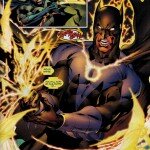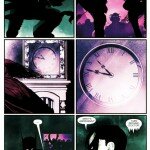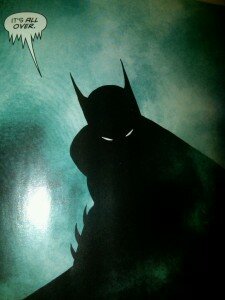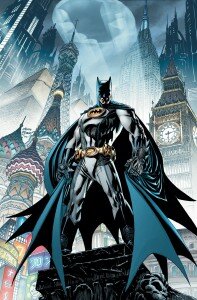When Grant Morrison announced his next major arc within the Batman universe, readers were confused as to why Morrison would have Batman create a corporation of crime fighters. I knew about Batman Inc. for awhile, but the If you look through some of the replies on the comments, you’ll notice a lone defender of the story named “Kyle” who seems to outlogic their hatred and include a bit of his own haterade to prove a point about internet trolls.
As you may have guessed, “Kyle” is me and here I am still defending Batman Inc. not because the story is amazing (it’s only on issue two, so a quality judgment is a bit early right now) but because the potential for the story is excellent and I understand what Morrison is going for in this arc.
Allow me to explain.
In “Pop Magic!” – Morrison’s manifesto on how to be a modern magician – the author writes about the power of viral sigils. He writes, “The viral sigil also known as the BRAND or LOGO is not of recent development (see ”Christianity,” “the Nazis” and any flag of any nation) but has become an inescapable global phenomenon in recent years.” He further goes on to write, “The McDonald’s Golden Arches, the Nike swoosh and the Virgin autograph are all corporate viral sigils.”
Essentially, the symbols that are associated with these corporations have certain connotations, feelings, and ideas connected to them. The feelings that one has towards that corporation are summoned forth once they see the symbol. For instance, seeing the McDonald’s golden arches can bring forth feelings of nostalgia for childhood, feelings of hunger, or perhaps feelings of queasiness. By simply observing this symbol (or viral corporate sigil), one can feel a mix of emotions.
Furthermore, McDonald’s (and all commercials in general) markets their brand to convey a feeling of fun and excitement.
EXPERIMENT: Notice how the music, the catchphrase, and the images work in concert to give the viewer an overall feeling of excitement and pleasure that comes with experiencing McDonald’s. Take some time to go through the commercial and think about why the marketing team chose the specific elements of the commercial. Why were certain images chosen? Why “I’m lovin’ it”?
Morrison goes on to explain:
Corporate sigils are super-breeders.They attack unbranded imaginative space.They invade Red Square, they infest the cranky streets of Tibet, they etch themselves into hairstyles. They breed across clothing, turning people into advertising hoardings. They are a very powerful development in the history of sigil magic, which dates back to the first bison drawn on the first cave wall.
The logo or brand, like any sigil, is a condensation, a compressed, symbolic summoning up of the world of desire which the corporation intends to represent. The logo is the only visible sign of the corporate intelligence seething behind it. Walt Disney died long ago but his sigil, that familiar, cartoonish signature, persists, carrying its own vast weight of meanings, associations, nostalgia and significance. People are born and grow up to become Disney executives, mouthing jargon and the credo of a living corporate entity. Walt Disney the man is long dead and frozen (or so folkmyth would have it) but Disney, the immense invisible corporate egregore persists.
With Batman Inc., Morrison has taken this concept of using corporations as a magic sigil to further an idea to a new level. The comic begs the question, “What if there were a corporation completely dedicated to saving lives?”
Some people have criticized the comic for taking the fun out of Batman, but the idea of Batman Inc is inherently fun. A privately funded, superhero corporation that takes the mythic status of the Batman symbol and presents it for the world to see.
 Perhaps the only problem is that the connotations associated with the Bat-symbol are inherently fearful. Take Batman’s role in the Geoff Johns run on Green Lantern. Batman has been selected for the Sinestro Corps because he has the ability to instill great fear. Turning the Batman symbol into a corporation seems a bit strange in this regard because it states that it is a symbol to be feared. Then again, perhaps that fear is only supposed to be struck into the hearts of criminals who are a superstitious and cowardly lot. Perhaps it brings comfort to those poor, unfortunate individuals who have been afflicted by crime.
Perhaps the only problem is that the connotations associated with the Bat-symbol are inherently fearful. Take Batman’s role in the Geoff Johns run on Green Lantern. Batman has been selected for the Sinestro Corps because he has the ability to instill great fear. Turning the Batman symbol into a corporation seems a bit strange in this regard because it states that it is a symbol to be feared. Then again, perhaps that fear is only supposed to be struck into the hearts of criminals who are a superstitious and cowardly lot. Perhaps it brings comfort to those poor, unfortunate individuals who have been afflicted by crime.
 In addition to Batman Inc, the set up for the corporate magic sigil has roots in Batman: Return of Bruce Wayne, where Bruce travels through time and solidifies the Batman symbol as something powerful and holy. From the cave people who worship the bat to the witch hunters, and Barbatos, Bruce is interacting with people to create a long mythology of the Bat so that once he finally does become Batman, he is something much more. As Dick Grayson describes him, he is a “Bat-God” and more than a mere man in a costume.
In addition to Batman Inc, the set up for the corporate magic sigil has roots in Batman: Return of Bruce Wayne, where Bruce travels through time and solidifies the Batman symbol as something powerful and holy. From the cave people who worship the bat to the witch hunters, and Barbatos, Bruce is interacting with people to create a long mythology of the Bat so that once he finally does become Batman, he is something much more. As Dick Grayson describes him, he is a “Bat-God” and more than a mere man in a costume.
Finally, Morrison has stated before (I believe in an IGN article, but I can’t for the life of me find it tonight) that caveman painted to visualize the outcome of their hunts. So, cavemen were essentially using fiction to cast out a spell to effect change into the world. Morrison goes on to say that comics are, in a sense, the same thing to him. By creating a corporate Batman, Morrison is trying to send out his idea of corporations being used for the good of the people rather than profit. Clearly, it’s not meant to be a literal idea of superheroes in our world, but rather, a figurative idea where corporations don’t have to be strictly for profit.
Maybe all of this analysis spoils the fun that is Batman Inc, but there have been enough ignorant complaints about the comic that I felt a defense of the idea was necessary in order to understand it further.





I believe most of the criticism comes from a place of wanting to see a specific type of Batman (Bruce Wayne), fight a specific type of crime (the Rogue’s Gallery). They don’t want Morrison shaking the status quo, no matter how bad that might get. Thing is, Morrison has been telling interesting stories, something Batman hasn’t done so well at in recent history. I admit that I had reservations after the first issue of Batman, Inc, but after the second issue, I reminded myself that this is essentially the beginning of a run. Even though Morrison has been writing Batman for the last few years, he is at a starting point. Did I think I would love his run when he introduced Damien and the Bat-Ninjas? At first, I was unsure, but I trusted the man and he delivered a powerful story to redefined the Batman Mythos. Batman, Inc. is the result of that. But we are now starting over (to a degree), and I’m sure in 2-3 years we will be amazed.
Well, when you put it THAT way I kind of want to read Batman.
I’m already amazed at the quality of the run as it’s a fresh take on a tried and true formula (Batman vs. the Gallery of Rogues and, of course, wins). I was skeptical when I first read of it, but now it is at the top of my “must read” list.
I think its ridiculous to say that Batman Inc. takes the fun out of Batman. I kinda feel like the Bat-verse has been overly serious the past year, with Stephanie Brown being the only exception. The Batman Inc. comic brought the fun back to comics. The stuff with Bruce and Selina was hella fun and I, for one, am looking forward to many more Batman Inc. comics.
Thanks for the post, and it’s important to point this stuff out. I’m not personally a huge fan of the comic thus far, but I appreciate what Morrison’s doing.
Awesome site. Just checked it out for the first time today.
I think you’re dead on with Morrison’s intent, though I do find it a hair similar to the X-Corp concept from his amazing run on New X-Men. I forgive it though, since Marvel pretty much got rid of all the progress he made. . . Only fair he get to run those ideas to their logical conclusion (hopefully) at DC. Its been different and exciting, with Morrison’s usual level excellence.
Sadly, comic book fans will find a reason to hate on anything. Some of us remind me of Jets fans at the draft, just showing up to boo. . .
Dave – you are absolutely correct! Morrison’s X-men was crafted in a similar vein, but where the two ideas diverge is that his X-men was supposed to lean towards an almost religious ideal rather than a corporate one. I would expound upon this, but I’ve decided to write about it for next week, so thanks for that!